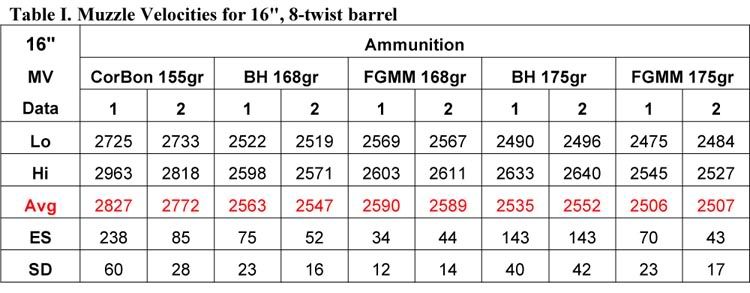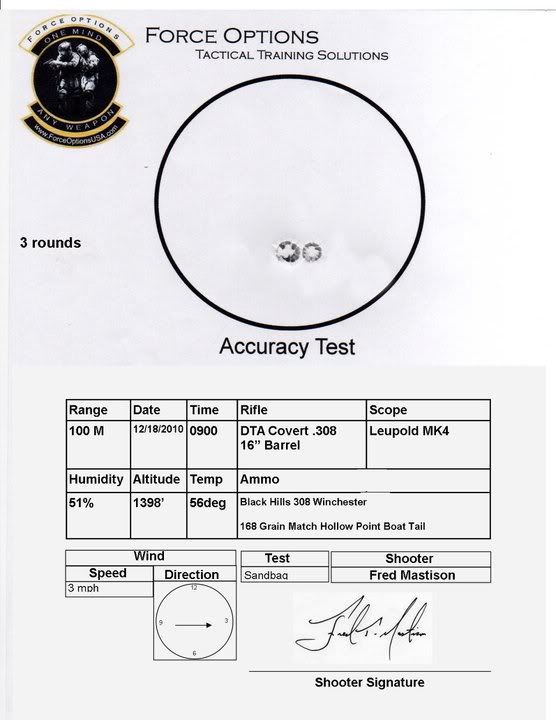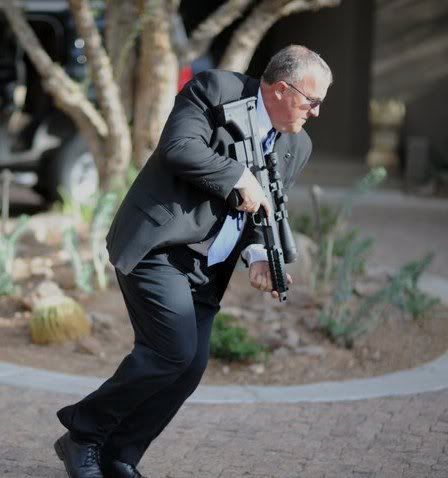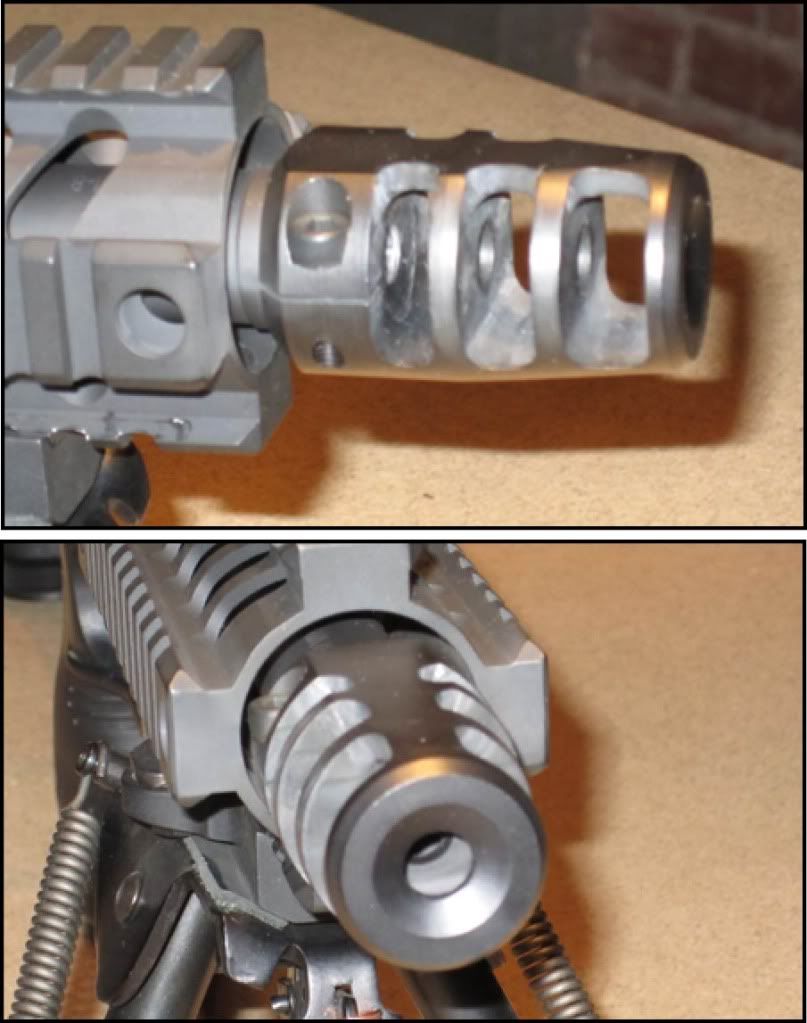Re: Idea! Official DTA SRS, HTI, Covert, Hunter Th
<span style="font-weight: bold">"A Covert Affair"</span>
A Novel by gstaylorg
In looking for a new rifle in .308 Winchester, there were several important factors I considered. Primarily, I wanted a bolt-operated weapon system that was small, relatively lightweight and easy to maneuver, and capable of accurate fire to at least 800 yd. Secondary considerations included an ability to handle heavier subsonic loads, ease of future modifications such as caliber exchange, and the ability to attach a suppressor. After considerable thought, the Desert Tactical Arms SRS Covert was the system I chose.
This weapons system represented many "firsts" for me; my first .308, my first bolt gun, my first bullpup rifle, etc. The barrel offered for the Covert system by DTA is a 16", 1 in 8" twist. Data previously posted on the Sniper's Hide forum by Fredo indicated this barrel was capable of remarkable muzzle velocities with factory loads considering its relatively short length. However, to be certain I would have a weapon that could reliably reach 800 yd, I also chose to order the 22", 1 in 11" twist barrel that is standard on the full-sized DTA SRS. Because I live in an urban area, after a great deal of deliberation, I finally decided to go with the "Urban Camo" color option (black). The complete description of this weapon system as tested is listed below:
<span style="font-weight: bold">DTA SRS Covert with 16", 1 in 8" twist barrel, muzzle brake
22", 1 in 11" barrel, muzzle brake
DTA rear monopod
Atlas V8 QD bipod
Nightforce 5.5-22x50, mil/mil, Zero Stop optic, LaRue LT-158 mount with 10 MOA cant</span>
Although many members of the Sniper's Hide forum have suggested that a barrel break-in procedure is unnecessary with most of today's barrels, I was unable to completely overcome my anal nature, and therefore carried out an abbreviated break-in procedure at an indoor range for each barrel. This procedure consisted of 3 single shots, followed by two groups of 3 shots (10 rounds total per barrel). At each step, the barrels were treated sequentially with Cu2+ remover, Hoppe's #9, Kroil, and Hoppe's Elite gun oil.
My initial impressions of the Covert were highly positive. This is a VERY solid weapon, but well-balanced and easy to handle. The overall length of the Covert chassis with the 16" barrel/muzzle brake was 29.7" and it weighed in fully loaded with bipod, optic, and 5 rounds + magazine at just under 14.5 lb. The Covert with the 22" barrel had an OAL of 35.5" and weighed in at 15.5 lb fully loaded. The ergonomics of this weapon system are very comfortable and well-thought out, particularly the pistol grip, trigger, and safety arrangement. This being my first bolt gun, I had no prior habits from other non-bullpup designs that created the need for any major "adjustments" in my shooting style in order to get comfortable behind the Covert. All-in-all, it was very comfortable weapon to shoot. I can imagine that an individual long-accustomed to a non-bullpup bolt gun might require a little more time to get a feel for the Covert, but it is so intuitive that I can't imagine such an adjustment would take much time or effort.
I should also point out that the trigger on the Covert was a real pleasure after years of shooting Sig 556s, which not only have a very long travel, but are also quite stiff (~7-8 lb pull). I did not test the pull on the Covert because I'm waiting on a Lyman pull gauge, and so left it at the factory setting. The trigger is very crisp with essentially no play, and is also a much lighter pull than my Sigs. As a first impression, if I had to say there was anything about the Covert that could be improved, it would be the magazines. Initially, I found them a little difficult to load, and they had some fairly sharp edges. However, I should also note that my opinion was much improved after running rounds through them for two days, whereupon they became quite easy to work with.
The other item worth mention is the volume level, particularly with the 16" barrel. No two ways about it, this thing is LOUD. I got in the habit of wearing double ear protection from shooting a Sig 556 pistol, which has a 10" barrel and is pretty loud. The Covert with its 16" barrel is definitely louder than the 556 pistol, so make sure you're wearing sufficient hearing protection if you're running one without a can like I am.
The images shown in Figure 1 are of the Covert with the 22" barrel, and include close-ups of the monopod, which I like every bit as much as my Accu-shots.
<span style="font-weight: bold">
Figure 1. DTA SRS Covert with 22" 11-twist barrel; rear monpod retracted/extended</span>
To better illustrate how compact the Covert really is, the Covert chassis with the 16" barrel is shown below a Sig 556 pistol with a 10.5" barrel (Fig. 2, left panel). The Covert chassis with the 22" barrel is shown next to a Sig 556 SWAT carbine with a 16" barrel (Fig. 2, right panel). With an overall length of just under 30" (as shown ) and weighing in at less than 15 lb fully loaded, I find it remarkable just how compact and maneuverable the Covert actually is. In fact it feels noticeably less "front heavy" than my Sig 556 SWATs, even though it's a little over 4 lb. heavier. Again, due to the well-designed ergonomics of this platform.
<span style="font-weight: bold">
Figure 2. Overall size of the Covert chassis with 16" and 22" barrels</span>
<span style="font-weight: bold">
Day 1: At the range with the Covert</span>
After receiving the Covert, the weather forecast indicated two days of reasonable weather (for Omaha in December, anyway), followed by a drop to sub-zero temperatures and near-blizzard conditions. I therefore put the most important priorities first and took two days off work to put the Covert through it paces. I can tell you that it was pretty painful taking two days off work just to spend time behind a new weapon at the range, but sometimes you do what you have to do. My primary goals were to determine muzzle velocity and accuracy at 100 yd for several different factory loads, then to get dialed in at longer distances on day 2. The following pics of the Covert and ammo are from day 1 at the range (Figure 3):
<span style="font-weight: bold">Figure 3. First day at the range with the Covert.</span>
About 20 rounds into day 1, I did this:
<span style="font-weight: bold">
Figure 4. When a .308 round unexpectedly meets Chrony diffuser support wires.</span>
I can't tell you how many times I've told other people, "Don't shoot the Chrony!". Fortunately, it was only the support wires for the diffuser panels. In any event, I decided to use the remainder of day 1 just to get comfortable behind the weapon and put a few rounds downrange, planning to get a lot more accomplished on day 2 (after repairing the Chrony, obviously).
<span style="font-weight: bold">Day 2: 600 yd range at Eastern Nebraska Gun Club</span>
Weather conditions: Temp. = 45°F, Air press. = 29.97 (S), hum. = 88%, elevation = 1060 ft., wind = ~15 mph from 6:00, with gusts to 25 mph.
<span style="font-weight: bold">Figure 5. ENGC 600 yd range.</span>
The following ammunition was tested through each barrel to determine muzzle velocity (and accuracy at 100 yd) using a Chrony Beta set at 10' from the muzzle:
1) CorBon 155 gr Scenar; factory test MV = <span style="font-weight: bold">2900 fps</span>
2) Black Hills 168 gr Match BTHP; factory test MV = <span style="font-weight: bold">2650 fps</span>
3) Federal GMM 168 gr SMK; factory test MV = <span style="font-weight: bold">2650 fps</span>
4) Black Hills 175 gr Match BTHP; factory test MV = <span style="font-weight: bold">2600 fps</span>
5) Federal GMM 175 gr SMK; factory test MV = <span style="font-weight: bold">2600 fps</span>
After 3-5 rounds to sight in, 4 x 5 round groups were used to determine accuracy and to determine muzzle velocity via two separate 10-shot strings.
The respective muzzle velocities measured for these ammo's from the 16", 8-twist and 22", 11-twist barrels are shown in Table I and Table II. Notably, the average decrease in muzzle velocity in the 16" barrel compared to the 22" barrel ranged from approximately 50 to 100 fps, depending on the ammo. Fredo recently posted similar values for other factory loads (See Sniper's Hide Official DTA SRS, Covert, Hunter thread; p13, at the following link:
http://www.snipershide.com/forum/ubbthreads.php?ubb=showflat&Number=1597047&page=1), which suggests that these numbers are not an anomaly. My overall feeling is that getting muzzle velocities of 2500 fps (or slightly better) out of a 16" barrel at 45 degrees F is phenomenal...possibly bordering on...can I say it...MAGIC. In any event, a 175 gr SMK at 2500 fps translates (via JBM Ballistics) into remaining supersonic slightly past 1000 yd, with a drop at that distance of 12.3 mil. Pretty impressive results for such a compact system and a 16" barrel.
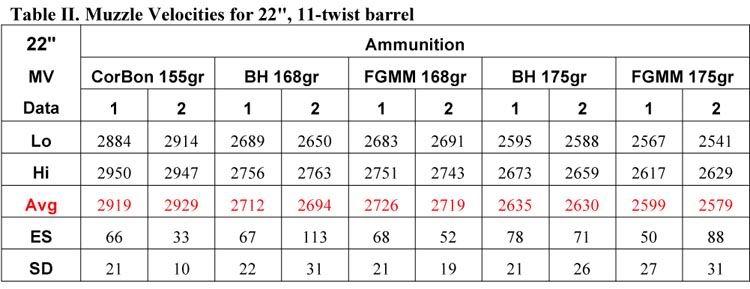
During the course of day 2, I also determined accuracies for these loads at 100 yd. Although I have no intention of wasting future time and effort punching holes in paper at 100 yd with this weapon system, it was convenient to kill two birds with one stone and generate both muzzle velocity and accuracy data at the same time. I should also note that the conditions on day 2 were not exactly optimal. Because I was shooting off a bench to use the Chrony, I found it very challenging to stay on target with varying/intermittent wind gusts from behind at 15-25 mph. This particular range has a slight downhill cant, so I don't think the wind had as much (if any) effect on the rounds after leaving the barrel as it did on me while trying to maintain proper hold. Having said that, I'm not too disappointed with the short range accuracy for my first couple of times behind the new Covert.
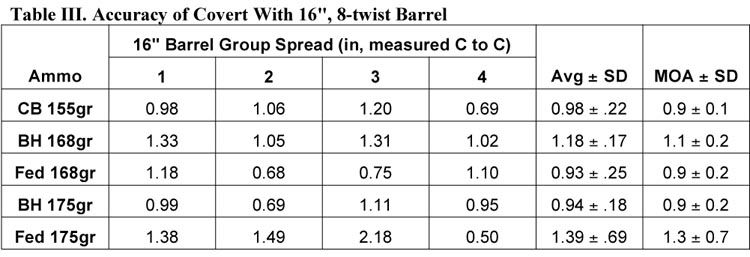
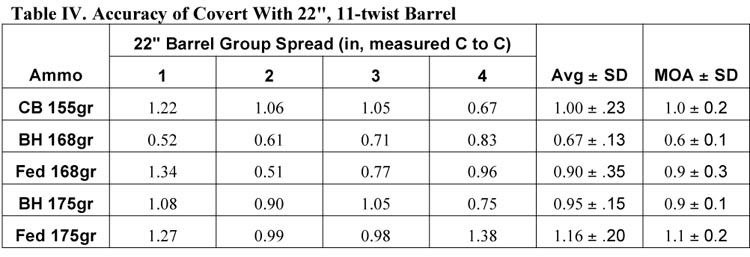
In Figure 6 (below) images of the best overall 4 x 5 shot groups for the two barrels are shown (BH 175 gr for the 16" barrel, BH 168 gr for the 22" barrel). Shown beneath each complete target image is the best single group from that target with the digital caliper measurement, and the three shot test target for that barrel from DTA.
The DTA three shot test target groups measured 0.40" and 0.38" for the 16" and 22" barrels, respectively. My best two single groups were obtained with the 22" barrel using Black Hills and Federal 168 gr loads (0.52" and 0.51", respectively). The best group I was able to obtain with the 16" barrel was 0.50" (Federal 175 gr) and just under 0.70" with Federal 168 gr and Black Hills 175 gr, respectively. Given the amount of buffeting that was taking place as I shot these groups, I am pretty comfortable stating that I believe I will be able to shoot close to 1/2" groups at 100 yds with either of these barrels from the prone position. At 600 and beyond? That's a whole different ballgame and only time and practice will tell.
<span style="font-weight: bold">Figure 6. Selected targets from Day 2 at the range.</span>
Ultimately, my goal is to become more proficient with this weapon at ranges significantly greater than 100 yd, and to do something more interesting than put a few holes in paper. I'm sorry I wasn't able to get a little further in testing the Covert so that I could include some data out to 600 yd. However, if Old Man Winter loosens his icy grip on the Midwest any time soon, that is next on the list and I will post the results when they are available. Overall, I couldn't be happier with the Covert; I think I made a very good choice. This is a very accurate, compact, and user-friendly weapon system, and I think it will do everything I had hoped when I ordered it.






